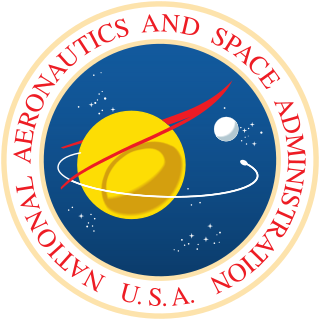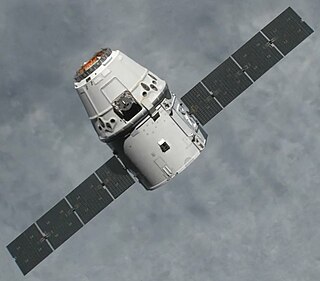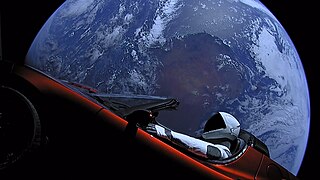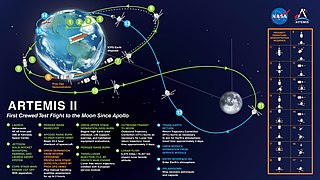Related Research Articles
This timeline of artificial satellites and space probes includes uncrewed spacecraft including technology demonstrators, observatories, lunar probes, and interplanetary probes. First satellites from each country are included. Not included are most Earth science satellites, commercial satellites or crewed missions.

Spaceflight began in the 20th century following theoretical and practical breakthroughs by Konstantin Tsiolkovsky, Robert H. Goddard, and Hermann Oberth, each of whom published works proposing rockets as the means for spaceflight. The first successful large-scale rocket programs were initiated in Nazi Germany by Wernher von Braun. The Soviet Union took the lead in the post-war Space Race, launching the first satellite, the first animal, the first human and the first woman into orbit. The United States landed the first men on the Moon in 1969. Through the late 20th century, France, the United Kingdom, Japan, and China were also working on projects to reach space.

The National Aeronautics and Space Administration is an independent agency of the U.S. federal government responsible for the civil space program, aeronautics research, and space research. Established in 1958, it succeeded the National Advisory Committee for Aeronautics (NACA) to give the U.S. space development effort a distinct civilian orientation, emphasizing peaceful applications in space science. It has since led most of America's space exploration programs, including Project Mercury, Project Gemini, the 1968–1972 Apollo Moon landing missions, the Skylab space station, and the Space Shuttle. Currently, NASA supports the International Space Station (ISS) along with the Commercial Crew Program, and oversees the development of the Orion spacecraft and the Space Launch System for the lunar Artemis program.

The year 2012 saw a number of significant events in spaceflight. In May and October, the first Commercial Orbital Transportation Services resupply missions took place, during which the SpaceX Dragon became the first private spacecraft to dock with the International Space Station (ISS). In June, China launched the crewed Shenzhou 9 orbital mission, and North Korea achieved its first successful orbital launch in December. 2012 also saw China's first successful asteroid exploration mission, and the landing of NASA's Curiosity rover on Mars. The Vega and Unha-3 rockets made their maiden flights in 2012, while the Proton-K made its last.

This article documents notable spaceflight events during the year 2019.

This article documents notable spaceflight events during the year 2018. For the first time since 1990, more than 100 orbital launches were performed globally.

This article documents expected notable spaceflight events during the 2020s.

The year 2022 witnessed the number of launches of SpaceX's Falcon rocket family surpassing the CNSA's Long March rocket family, making the United States the country with the highest number of launches in 2022 instead of China. This year also featured the first successful launch of Long March 6A, Nuri, Angara 1.2, Vega-C, Kinetica-1, and Jielong-3. National space agencies' activities in this year is also marred by the Russian invasion of Ukraine, leading to tension between Roscosmos and Western space agencies, threats of ending collaboration on the International Space Station (ISS), and delays on space missions.

The year 2024 is expected to exceed 2023's 223 orbital launches. So far, the year saw the successful first launch of Vulcan Centaur, Gravity-1, Ariane 6, and notably more developmental launches of SpaceX's Starship – with IFT-3, IFT-4, IFT-5, and IFT-6 planned for this year. Additionally, the final launch of a Delta family rocket occurred in April with a Delta IV Heavy. In May, China launched the Chang'e 6, the first sample return from the far side of the Moon.

This article documents expected notable spaceflight events during the year 2026.

Spaceflight in 2025 promises to follow the 2020s trend of record breaking orbital launches and increased developments in lunar, Mars and low-earth orbit exploration.

This article documents expected notable spaceflight events during the year 2027.
Tianlian also known as CTDRS, is a Chinese data relay communication satellite constellation. The constellation serves to relay data from ground stations to spacecraft and rockets, most significantly China's crewed spaceflight program. The system currently consists of seven satellites in two generations, with the first satellite being launched in 2008.

The Long March 6A or Chang Zheng 6A as in pinyin, abbreviated LM 6A for export or CZ 6A within China, is a Chinese medium-lift launch vehicle in the Long March family, which was developed by the China Aerospace Science and Technology Corporation (CASC) and the Shanghai Academy of Spaceflight Technology (SAST).
Yunhai-3 is the third set of satellites in a series of Chinese meteorological satellites developed by the Chinese military. The satellites are built by the China Aerospace Science and Technology Corporation (CASC) and then transported to Taiyuan for launch. Their main uses are in the fields of atmospheric data for weather prediction, ionosphere, gravity and climate research, as well as disaster prevention. Like the Yunhai-2 series, the satellites reportedly use the Global Navigation Satellite System Radio Occultation (GNSS-RO).
References
- ↑ "NASA - NSSDCA - Spacecraft - Details". nssdc.gsfc.nasa.gov. Retrieved 2024-03-26.
- ↑ Jones, Andrew (2024-03-21). "China launches second batch of Yunhai-2 satellites". SpaceNews. Retrieved 2024-03-26.